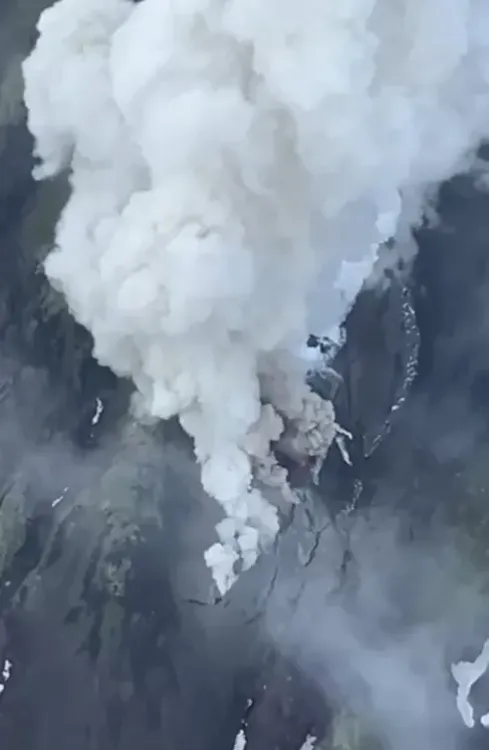What Happened at the Russian Volcano Klyuchevskoy?

Synopsis
Key Takeaways
- Klyuchevskoy volcano released an ash plume reaching 7 kilometers high.
- The eruption poses potential hazards to aviation.
- Authorities have declared an orange aviation colour code.
- No populated areas are currently affected by ash fallout.
- Recent seismic activity may have triggered the volcanic eruptions.
Moscow, Aug 5 (NationPress) The Klyuchevskoy volcano located in Russia's far eastern Kamchatka Peninsula released an ash plume that soared up to 7 kilometres above sea level on Tuesday, with the ash cloud moving southeast towards the Pacific Ocean, as reported by local authorities.
According to the Kamchatka branch of the Ministry of Emergency Situations on their Telegram channel, no settlements are in the ash cloud's trajectory, and no ash fallout has been observed in populated areas. Additionally, there are no registered tourist groups in the vicinity of the volcano at this time.
The volcano has been categorized with an orange aviation colour code, signifying a significant risk of ash emissions and potential threats to aviation.
Activity at the volcano increased on Monday, with the Kamchatka branch of the Geophysical Service of the Russian Academy of Sciences identifying four distinct ash plumes from Klyuchevskoy, the highest of which reached 9 kilometres above sea level, according to reports from Xinhua news agency.
Authorities indicated that ash emissions between 6 to 10 kilometres are still possible from several active volcanoes in the region and have advised both residents and tourists to refrain from traveling within a 10-kilometre radius of these volcanoes.
At an elevation of 4,754 meters above sea level, Klyuchevskoy is recognized as the tallest active volcano in Eurasia and is situated in the Ust-Kamchatsky District. Its current eruptive phase commenced in April.
This volcanic activity follows a powerful 8.8-magnitude earthquake that struck Kamchatka on July 30, marking the strongest quake in the region since 1952. The earthquake was felt as far away as the northern Kuril Islands, leading to a tsunami warning and a state of emergency in the Severo-Kurilsk district.
“Our data indicates that the last significant volcanic activity in Kamchatka occurred in 1737, following a magnitude-9 earthquake,” stated Alexey Ozerov, Director of the Institute of Volcanology and Seismology of the Far Eastern Branch of the Russian Academy of Sciences, as quoted by TASS news agency.
Ozerov mentioned that the seismic event on July 30 may have reawakened the region's “sleeping giants.”
Yury Demyanchuk, head of the volcanology station in Klyuchi, remarked that he has never observed such widespread volcanic activity in his 50 years of work in Kamchatka, as reported by Xinhua news agency.
“At Krasheninnikov Volcano, both summit and central eruptions have commenced simultaneously, which could suggest intense internal seismic processes. Regarding Kambalny Volcano, I last studied it in 1979, and although it has been quiet for decades, it should not be considered extinct,” Demyanchuk explained.
He noted that the last eruption of Krasheninnikov likely took place in the 15th century and is documented only through layers of volcanic ash. “Of course, no one was monitoring it in the 1400s, so we can assert that we are witnessing truly unique natural phenomena today,” he added.
As of Sunday, six volcanoes were exhibiting active signs: Avachinsky, Klyuchevskoy, Bezymianny, Kambalny, Karymsky, and the recently active Krasheninnikov, located in the Kronotsky Nature Reserve.









